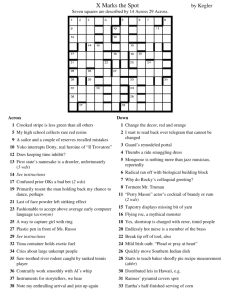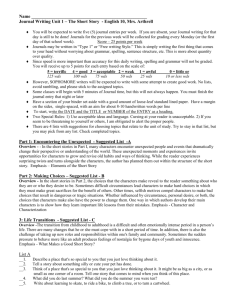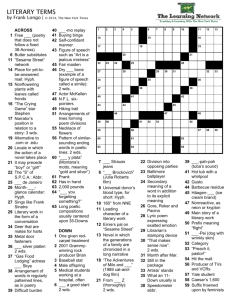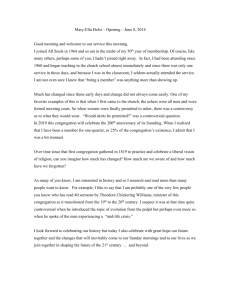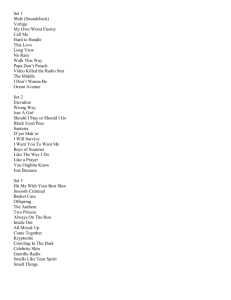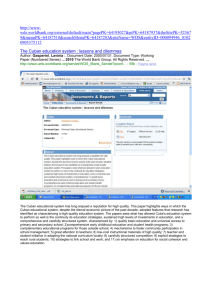Religion and Regulation - Kansas State University College of
advertisement
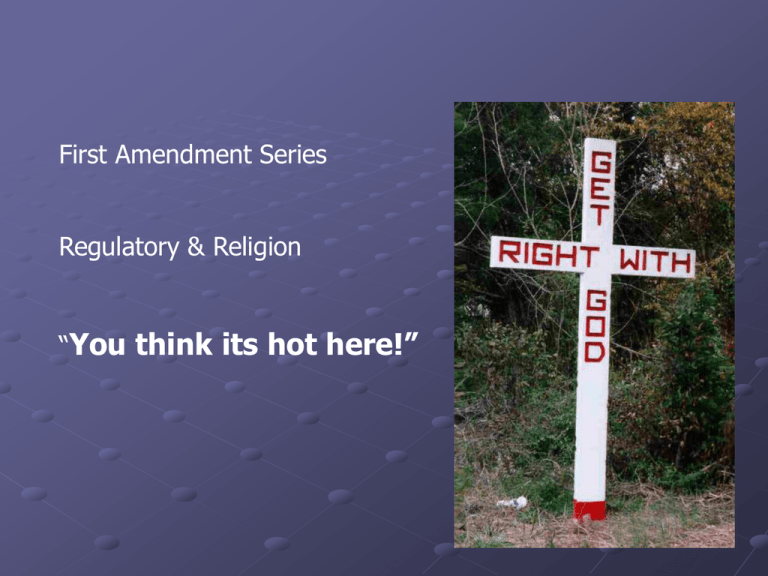
First Amendment Series Regulatory & Religion “You think its hot here!” Religion and Regulation "Congress shall make no law respecting an establishment of religion, or prohibiting the free exercise thereof.“ The first part of this provision is known as the Establishment Clause, and the second part is known as the Free Exercise Clause. Although the First Amendment only refers to Congress, the U.S. Supreme Court has held that the Fourteenth Amendment makes the Free Exercise and Establishment Clauses also binding on states.” The Meaning of the Establishment Clause The government cannot enact legislation that aids one religion, aids all religions, or prefers one religion over another. It cannot force or influence a person to participate in, or avoid, religion or force a person to profess a particular religious belief. No tax in any amount can be levied to support any religious activities or organizations. Neither a state nor the federal government can participate, whether openly or secretly, in the affairs of any religious groups. Basics To determine whether an action of the federal or state government infringes upon a person's right to freedom of religion, the court must decide what qualifies as religion or religious activities for purposes of the First Amendment. What Qualifies? Religion is "a behavior, process or structure whose orientation is at least partially supernatural." But not always: The 7th Circuit Court of Appeals ruled that prison officials erred because they “did not treat atheism as a ‘religion.’” The court said, “Atheism is [the inmate’s] religion, and the group that he wanted to start was religious in nature even though it expressly rejects a belief in a supreme being The Supreme Court has said that a religion need not be based on a belief in the existence of a supreme being. In the 1961 case of Torcaso v. Watkins, the Court described “secular humanism” as a religion Secular Humanism A humanist philosophy that upholds reason, ethics, and justice and specifically rejects rituals and ceremonies as a means to affirm a life stance. The term was coined in the 20th century to make a clear distinction from "religious humanism". A perhaps less confrontational synonym is scientific humanism, which the biologist Edward O. Wilson claimed to be "the only worldview compatible with science's growing knowledge of the real world and the laws of nature". A Wide Variety Abode of the Eternal Tao - Taoism(12 million) Yoruba Voodoo – Shango – Santariaism (1.2 million) Rastafarianism (700,000) Janism Syro Manlankara So, Can Religion Be Regulated? The Lemon Test 403 US 602, 1972 quoting Lemon v Kurtzman The Lemon Test - First, the statute must have a secular legislative purpose Second, its principal or primary effect must be one that neither advances nor inhibits religion Finally, the statute must not foster "an excessive governmental entanglement with religion." The Witnesses v Lakewood Congregation Of Jehovah’s Witnesses v. Lakewood Ohio Does a local zoning ordinance that prohibits the construction of churches in virtually all zoning districts, violate the Establishment Clause of the First Amendment. Lakewood, Ohio is a suburb of Cleveland with a population of 51,000. The land use is dominated by 1 and 2 family houses within a linear commercial district. There are few vacant lots remaining in the town Background The 175-member Congregation of Jehovah's witnesses, a nonprofit corporation organized under Ohio law, has worshipped in Lakewood since 1944 The Congregation's church building, called Kingdom Hall, is currently located in a storefront on one of the main commercial arteries in the City - 1993 The central tenets and missions of the Jehovah's Witnesses are the distribution of literature to homes and on the street, and the conduct of in-home Bible studies for the purpose of instructing and encouraging people to apply biblical teachings to daily life. Controversy The Congregation decided to relocate Kingdom Hall and began searching for a site capable of accommodating a larger building. It entered into an option contract for and subsequently purchased a half-acre lot in northwest Lakewood The surrounding neighborhood consists of large, stately one and two-family homes, most of which were constructed before 1930. The design for the new Kingdom Hall featured a low, square building with a rustic stone exterior intended to blend with the neighboring properties. The design, insofar as possible, preserved the trees on the land and sheltered the forty-two car parking lot from homes nearby. The Problem The Congregation's lot is designated R-2, limiting its uses to single family dwellings and "roomers." Church buildings are permitted only in M-3, M-2, B-R, and B-2 districts, which comprise approximately ten percent of the City's land. The Allegation The Congregation claims that the ordinance infringes on its right to freedom of religion by prohibiting it from constructing Kingdom Hall on the lot it owns If the ordinance does infringe the Congregation's first amendment rights, the City must justify the ordinance by a compelling governmental interest (strict scrutiny). A Cardinal Principle of Faith Although a court's primary concern in determining whether religious freedom has been infringed must necessarily be the cost, economic or otherwise, attached to religious observance, case law highlights a secondary concern The centrality of the burdened religious observance to the believer's faith influences the determination of an infringement. Religious observances in the form of beliefs are absolutely protected from governmental infringement. The First Finding The burdens imposed on the Congregation by the ordinance are an indirect financial burden and a subjective aesthetic burden. The Congregation may build a church in Lakewood only in commercial or multi-family residential district. Land in these districts is more expensive and, the Congregation claims, less conducive to worship than the area where the lot is located. No pressure is placed on the Congregation to abandon its beliefs and observances. Second Finding But the First Amendment does not require the City to make all land or even the cheapest or most beautiful land available to churches. The Lakewood ordinance does not exclude the exercise of a first amendment right, religious worship, from the City. Summary In summary, the Lakewood ordinance is constitutional although it creates exclusive residential districts and thereby prohibits the construction of church buildings in the districts The facts of the present case show that the ordinance does not infringe the Congregation's religious freedom The ordinance merely frustrates the Congregation's desire to locate itself in a more pleasant, more convenient and less expensive location. Such desires, however, are not protected by the Constitution. Lemon test Applied the statute must have a secular legislative purpose Second, its principal or primary effect must be one that neither advances nor inhibits religion Finally, the statute must not foster "an excessive governmental entanglement with religion." City of Colorado Springs V Rev. Blanch Case filed in 1984 • Faith Bible owned and operated a church in Colorado Springs that was sold in April 1985 • Faith Bible purchased residential property at 2804 Country Club Circle City of Colorado Springs v Richard Blanch Title was conveyed to Blanche and his wife. Blanche and Faith Bible commenced, organized, and institutionalized religious activities within the residence knowing that the property was located in an R-1 district. In an R-1 zone, religious institutions are not allowed as a permitted use, but may be allowed as a conditional use. Background Richard Blanche, who is the pastor for Faith Bible, and his family live in the Country Club Circle home. The residence is a four bedroom home with a family room containing a piano and approximately 50 folding chairs set up in rows facing a podium. Blanche conducts religious services and other congregational activities at the home four times a week. These activities, which typically included sixty to seventy-five people, consisted of praying, singing, studying the bible, and teaching Sunday school. The Good Rev. In Front of His Church He Also Does Healing The Curtin Rises Colorado Springs issues a violation notice to the Rev. Blanch to cease operation as a church Blanch says to go take a hike Blanch is hauled into local court, fined $250 and ordered to perform 80 hours of community service Lights, Action Blanch holds services again Brought back to court and fined $1,000 Courts issues permanent restraining order prohibiting the use of the home as a church Blanch does it again and the court holds him and Faith Bible in contempt and fines him another $1,000 The congregation passes the plate The Star of the Show - Blanch Blanche and Faith Bible claim that the City of Colorado Springs denied them due process and equal protection of the law by unconstitutionally abridging appellants' rights to freedom of speech, assembly, association, and religion. The Court Answers Colorado Spring did not abuse its authority Content neutral regulations that exclude religious uses from certain zones are constitutional insofar as the rules for the exclusion are rationally related to the goals of the police power This is a time, manner, place restriction and is based on the very real needs for parking, low intensity neighborhood activity The Free Exercise Test Whether the "exercise of religion" was adversely affected by the regulation Whether the action "substantially burdened" the exercise of religion Whether the action was "in furtherance of a compelling governmental interest Whether the action was "the least restrictive means of furthering that compelling governmental interest Cardinal Principles But what if a cardinal principle of a religion brought harm to others or animals? Quick Facts Hialeah, Florida – part of the Miami-Dade County Metropolitan area Current population about 225,000 Notable high-income suburb Church Of The Lukumi Babalu Aye v City of Hialeah Santeria (The Way of the Saints) is the common, popular name. Quoting an essay on "The Lukumi Tradition" by Afolabi: Vodun (a.k.a. Vodoun, Voudou, Voodoo, Sevi Lwa) is commonly called Voodoo by the public. The name is traceable to an African word for "spirit". Vodun's can be directly traced to the West African Yoruba people who lived in 18th and 19th century Dahomey Of Animal Sacrifice and Zoning This case involves practices of the Santeria religion, which originated in the nineteenth century. When hundreds of thousands of members of the Yoruba people were brought as slaves from eastern Africa to Cuba, their traditional African religion absorbed significant elements of Roman Catholicism The resulting syncretion, or fusion, is Santeria, -the way of the saints.- The Cuban Yoruba express their devotion to spirits, called orishas, through the iconography of Catholic saints, Catholic symbols are often present at Santeria rites, and Santeria devotees attend the Catholic sacraments. The God’s Of Santeria ELEGGUA OBATALA OSHUN OYA YEMALLA SHANGO The Controversy According to Santeria teaching, the orishas are powerful but not immortal. They depend for survival on the sacrifice. Sacrifices are performed at birth, marriage, and death rites, for the cure of the sick, for the initiation of new members and priests, and during an annual celebration. Animals sacrificed in Santeria rituals include chickens, pigeons, doves, ducks, guinea pigs, goats, sheep,…. The animals are killed by the cutting of the carotid arteries in the neck. The sacrificed animal is cooked and eaten, except after healing and death rituals. The Controversy The prospect of a Santeria church in their midst was distressing to many members of the Hialeah community, and the announcement of the plans to open a Santeria church in Hialeah prompted the city council to hold an emergency public session on June 9, 1987. The Animal Sacrifice The Result The ordinance defined sacrifice as: [i]t shall be unlawful for any person, persons, corporations or associations to sacrifice any animal within the corporate limits of the City of Hialeah, Florida. The final Ordinance, 87-72, defined slaughter as the killing of animals for food and prohibited slaughter outside of areas zoned for slaughter house use. The ordinance provided an exemption, however, for the slaughter or processing for sale of small numbers of hogs and/or cattle per week in accordance with an exemption provided by state law. All ordinances and resolutions passed the city council by unanimous vote. The Trial Court First, the court found that animal sacrifices present a substantial health risk, both to participants and the general public. The court found emotional injury to children who witness the sacrifice of animals. Third, the court found compelling the city's interest in protecting animals from cruel and unnecessary killing. The court determined that the method of killing used in Santeria sacrifice was unreliable and not humane, and that the animals, before being sacrificed, are often kept in conditions that produce a great deal of fear and stress in the animal Fourth, the District Court found compelling the city's interest in restricting the slaughter or sacrifice of animals to areas zoned for slaughterhouse use. The Supreme Court The city does not argue that Santeria is not a religion within the meaning of the First Amendment. Nor could it. Although the practice of animal sacrifice may seem abhorrent to some, religious beliefs need not be acceptable, logical, consistent, or comprehensible to others in order to merit First Amendment protection. Kennedy’s Observation Our review confirms that the laws in question were enacted by officials who did not understand, failed to perceive, or chose to ignore the fact that their official actions violated the Nation's essential commitment to religious freedom The challenged laws had an impermissible object; and in all events the principle of general applicability was violated because the secular ends asserted in defense of the laws were pursued only with respect to conduct motivated by religious beliefs. Justice Kennedy Neutrality In sum, the neutrality inquiry leads to one conclusion: The ordinances had as their object the suppression of religion. The pattern we have recited discloses animosity to Santeria adherents and their religious practices; the ordinances by their own terms target this religious exercise; the texts of the ordinances were crafted with care to proscribe religious killings of animals but to exclude almost all secular killings; and the ordinances suppress much more religious conduct than is necessary in order to achieve the legitimate ends asserted in their defense. “Every time You Go To Church It Is A Matter Of Life Or Death” The practice of snake handling is based in the Gospel according to St. Mark, Chapter 16, verses 17 and 18. In this passage, Jesus says, "And these signs shall follow them that believe; In my name shall they cast out devils; they shall speak with new tongues; they shall take up serpents; and if they drink any deadly thing, it shall not hurt them; they shall lay hands on the sick, and they shall recover." Archbishop of San Antonio v City of Boerne, Texas Located in the San Antonio Metro Area in the west Texas Hill Country 2005 population about 8,000 people San Antonio Metro Area Religious Freedoms Restoration Act (RFRA) of 1993 In this case the Supreme Court finds that the RFRA is a significant intrusion of Congress on the ability of the State’s to enact health, safety, and welfare laws for the good of its communities City of Boerne (Pronounced BURnee) v Archbishop of San Antonio The Setting Situated on a hill in the city of Boerne, Texas, some 28 miles northwest of San Antonio, is St. Peters Catholic Church. Built in 1923, the church's structure replicates the mission style of the region's earlier history. The church seats about 230 worshippers, a number too small for its growing parish. Some 40 to 60 parishioners cannot be accommodated at some Sunday masses. In order to meet the needs of the congregation the Archbishop of San Antonio gave permission to the parish to plan alterations to enlarge the building. The Spanish Mission Style El Bishop The Bishop Toasting His Decision to Allow The Church to Renovate and Expand Action of the City The Boerne City Council passed an ordinance authorizing the city's Historic Landmark Commission to prepare a preservation plan with proposed historic landmarks and districts. The Commission must pre-approve construction affecting historic landmarks or buildings in a historic district The Archbishop applied for a building permit to enlarge the church City authorities, relying on the ordinance and the designation of a historic district denied the application. The Archbishop brought this suit challenging the permit denial in the United States District Court The RFRA Itself The impact of the Religious Freedom’s Restoration Act requires a State to demonstrate a compelling interest and show that it has adopted the least restrictive means of achieving that interest. This is the most demanding test known to constitutional law. The RFRA is Unconstitutional If the historic landmark on the hill in Boerne happened to be a museum or an art gallery owned by an atheist, it would not be eligible for an exemption from the city ordinances that forbid an enlargement of the structure. Because the landmark is owned by the Catholic Church, it is claimed that RFRA gives its owner a federal statutory entitlement to an exemption from a generally applicable, neutral civil law. Who Should Prevail? Whether the Church would actually prevail under the statute or not, the statute has provided the Church with a legal weapon that no atheist or agnostic can obtain. This governmental preference for religion, as opposed to irreligion, is forbidden by the First Amendment. No Comment ACLU v City Of Jersey City, NJ Of Sleds and Snowmen First Amendment activist John Messina is challenging a Christian nativity creches in a public park. He charges that the "Christmas in the Park" festival uses tax money, and should not be a venue for religious proselytizing. In School Dist. of Abington Township v. Schempp (1963), Justice Goldberg, joined by Justice Harlan, wrote, in respect to the First Amendment's Religion Clauses, that there is "no simple and clear measure which by precise application can readily and invariably demark the permissible from the impermissible." One must refer instead to the basic purposes of those Clauses. They seek to "assure the fullest possible scope of religious liberty and tolerance for all." They seek to avoid that divisiveness based upon religion that promotes social conflict, sapping the strength of government and religion alike. 1St Amendment Bedrock Principle The Constitution provides no guidance on matters of taste or aesthetics, it does provide protection for citizens to erect even the most energy-consuming, taste-challenged holiday display. In particular, the Free Exercise Clause guarantees the citizen's right to celebrate the season's religious origins. Thus, while the individual citizen can express himself or herself freely during the holiday season through the display of religious symbols, the Establishment Clause imposes constraints on the content of government-sponsored holiday displays. Take Home Point The Establishment Clause prevents government from sponsoring, celebrating, or endorsing religion. Background The City of Jersey City normally displays a Christian Nativity Scene and a Menorah during the holidays. After a number of formal complaints, the City added a decorated Christmas Tree and a sign that explained that the display was intended to celebrate the diversity of its citizens. District Court The District Court issued a preliminary injunction against Jersey City not to display the Nativity Scene and the Menorah. The following year, however, the City once again displayed both scenes and added – Santa Clause, Frosty the Snowman, and a red, wooden snow sled. + + ACLU Actions – Supreme Court The ACLU requested a permanent injunction and civil penalties against the City for violation of the first injunction The Lemon test is a three-pronged test requiring the following: (1) the statute or government practice must have a secular purpose; (2) its practical effect must be one that neither advances nor inhibits religion; and (3) the statute or government practice must not foster "an excessive government entanglement with religion." Key Points “We note that the expenditure of public funds to erect and maintain a religious display directly implicates the Establishment Clause Jersey City's display was erected and maintained with public funds. If a city taxpayer objected to the religious display, he or she could not have opted out of contribution to the display, even if fundamentally repugnant to his or her own beliefs.” Point Two Jersey City's display of a creche was accompanied by a menorah, a sign, and a Christmas tree. Jersey City maintains that this context alters the message of endorsement conveyed by the display of the creche. The menorah is a religious symbol and when displayed with a creche, the menorah's religious significance is emphasized. CONTINUED Moreover, the token inclusion of the Christmas tree does little to mitigate the religious message of the creche and the menorah. Thus, the display cannot be viewed as anything but a constitutionally impermissible dual endorsement of Christianity and Judaism. Point Three There are three reasons why the City's diversity/pluralism justification fails to pass constitutional muster First, government endorsement of one of any number of different religions is unconstitutional. Second, a reasonable observer cannot be presumed to be aware of the various religious and cultural celebrations that take place throughout the year in Jersey City. Conclusion The City's policy of celebrating many different religions, while perhaps laudable, is a classic example of government entanglement with religion. Justice Breyer, June 27, 2005 If the relation between government and religion is one of separation, but not of mutual hostility and suspicion, one will inevitably find difficult borderline cases. And in such cases, I see no test-related substitute for the exercise of legal judgment The Jesus Center v Farmington Hills To what extent may a local government, through its zoning authority, limit a church from undertaking, in the name of religion, activities that have a negative effect on the church's neighbors? The key to understanding this case is how much a regulation can burden a religious activity Western Suburb Region Jesus Center Staff Basic Facts The Jesus Center, rents a two-story building in a residential area. The church holds traditional services there, including Sunday morning and evening worship, weekly Bible study, and prayer meetings. For some time, The Jesus Center has also used the location as a collection and distribution point to supply food, clothing, and other essentials to needy persons. Expansion The controversy at issue here began in 1991 when The Jesus Center broadened its ministry to provide a shelter service to poor people, including some who are homeless . When the City of Farmington Hills (the City) learned about the shelter service, The Jesus Center was informed that it would be required to get zoning approval for this use of the property . The Jesus Center submitted an application to respondent, Farmington Hills Zoning Board of Appeals, requesting a ruling that the provision of shelter services was a permitted "accessory use" to the principal use of the property as a church. The Hearing People from the largely residential neighborhood surrounding were fearful for their families' safety because occupants of the shelter had approached residents asking for money, theft had increased since the shelter opened, and people from the shelter were loitering, trespassing on private property Others said that persons served by the shelter were alcohol abusers and that persons from the shelter had been seen urinating outside a local party store. Opponents of the application contended that the shelter was in operation all week long, not just on weekends, and also complained that the homeless were being bussed in from other communities. Here is How the Neighbors Saw It The Jesus Center Says Proponents of The Jesus Center argued that operation of the shelter was part of its religious mission| They attempted to address community concerns by assuring that the shelter operated only on weekend nights during the winter, that the occupants were referred by the Neighborhood Services Organization, The Salvation Army, etc., and that the occupants were screened for drugs and alcohol before being accepted The persons receiving shelter services were closely supervised and not allowed to leave the center to wander into the neighborhood. The Results The Board of Zoning Appeals rules that a homeless shelter/soup kitchen was not an allowed accessory use to a place of worship. An accessory is subordinate to the principal use of the land, is normal and customary, and is integral and supportive of the principal use Interpretation The Appeals court finds that the Board’s refusal to interpret a Homeless Shelter as a permitted use “substantially burdens” the Jesus Center’s exercise of free religious practices The court cites the fact that acts of charity and service to the poor are nearly universal in all religions Providing sanctuary and shelter to the poor has been part of the Judeo-Christian tradition for over two millennium And Also Finds Total prohibition was not the least restrictive means of limiting the land use rights of the Jesus Center. Arnold is incensed over the decision of the court and vows to pump the neighborhood up Westchester Day School, 2002 Village of Mamaroneck, NY 28,752 persons 38.8 median age 84,283 median income $553,033 median house The School The School Background The Westchester Day School [WDS] applies to the Village Zoning Board [VZB] for a permit to enlarge their school facilities The VZB examined the applicant for site location, environmental impact and, after two months of deliberation turns down the application The WDS files suit in federal court asserting the Village violated their rights under the RLUIPA (Religious Land Use and Institutionalized Persons Act of 2000) statute – by substantially burdening their right of the free exercise of religion Religious Land Use and Institutionalized Persons Act of 2000 No government shall impose or implement a land use regulation in a manner that imposes a substantial burden on the religious exercise of a person, including a religious assembly or institution, unless the government demonstrates that imposition of the burden on that person, assembly or institution (A) is in furtherance of a compelling governmental interest; and (B) is the least restrictive means of furthering that compelling governmental interest. Basis of Claim By The WDS WDS states that their existing facilities, some more that a century old, are inadequate for activities deemed necessary for its educational and religious mission WDS proposes to construct "Gordon Hall" to provide the school with many of the basic facilities it currently lacks, The additional classrooms will also enable the school to have smaller classes that are more conducive to learning, to allocate more rationally the space among the preschool, elementary school and middle school grades and to separate administrative functions from educational activities. Heart of the Issue The issue of whether WDS has made a prima facie case that RLUIPA has been violated. To make such a showing, plaintiff must present evidence that defendants' conduct in denying the application (1) imposes a substantial burden; (2) on the "religious exercise;" (3) of a person, institution or assembly. The Village Responds Defendants charge that WDS has failed to demonstrate how the Village is substantially burdening their exercise of religion where the students at WDS have been, and continue to be, able to gather to pray and be educated just as they did before WDS applied for a modification of a special use permit. WDS Counters WDS should be able within reason, to accommodate the growing number of students who wish to pursue a Jewish education at WDS. Not be allowed to do so constitutes interference with their religion The Court Comments on the VZB Reasons for Denial There are two major reasons for denying WDS's Application -- traffic and parking. With respect to the issue of traffic intensity, we are unpersuaded by the opinions of additional experts relied on by defendants (since the ZBA's initial study of the potential adverse effects on traffic) which call into question the validity of WDS's traffic study. In any event, traffic concerns have never been deemed compelling government interests: Important, but not compelling."). We find defendants' second concern, parking, even less compelling. Defendants' denial of the application based on an insufficient number of parking spaces is severely undermined by the joint request of both the Westchester County Planning Board and by the ZBA to decrease the number of parking spaces provided for in the application. Conclusion We are firmly convinced that defendants' complete denial of WDS's Application was not based on any compelling governmental interest or on a fair balancing of environmental concerns with the rights to WDS to the reasonable use of its property Defendants' abrupt reversal of its prior approval and its 3-2 vote to deny plaintiff's Application was a reaction to belated public outcry We find little rational basis for such community opposition in light of the nature and publicly beneficial purpose of the project as well as the great lengths to which WDS has gone to ensure that its physical plant will maintain the highest level of architectural and aesthetic quality Repent! The End
